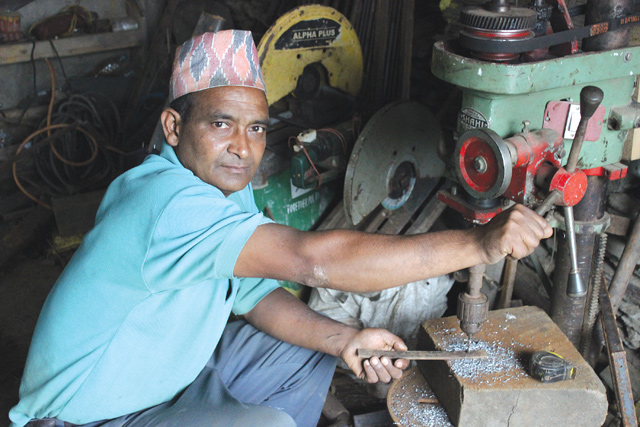With electrification, Barpak is back in business
Gorkha, July 29, 2016: Resh Bahadur Ghale’s saw mill has been running non-stop this rainy season, slicing large planks of wood since Barpak’s 133 kW micro-hydro plant started generating power again in April.
It took a full year for electricity to be restored in Barpak, the town nearest to the epicentre of last year’s 7.8-magnitude earthquake. But the power is making rebuilding possible.
“I have lost count of the number of doors and windows we made in the last three months,†said Resh Bahadur. “There are over a thousand houses to rebuild in this village.†Only a year ago, he was making beds, cupboards, dressers, chairs and benches for Barpak’s houses, now his workshop is adapting to theneeds of reconstruction.
“Earlier, people had homes and wanted items to make their lives comfortable, but now the bulk of our work is for doors and windows. We are moving with the times,†he adds.
Resh Bahadur started his Naradkunda Kashtha Udhyog some 20 years ago, when Barpak’s first 50 kW power plant was installed. His ancestors had been grazing sheep on the slopes of Baudha Himal for centuries. Ghale remembers seeing good wood rotting in the forest as he herded his cattle to and from higher pastures in the summer. So he approached Bir Bahadur Ghale — who had built the Ghatte Khola micro-hydro plant — for advice and then set up his own furniture business.
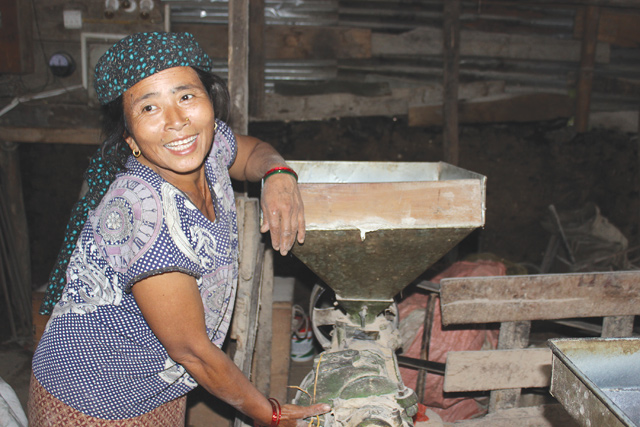
The April and May 2015 quakes demolished Barpak’s schools, health posts, and local businesses, including Resh Bahadur’s workshop. Only four of Barpak’s 1,200 houses were left standing, and his own 99-year-old father died when his buffalo shed collapsed.
Villagers had just finished with the funerals of the 700 who were killed, when the monsoon season started. The roads to Barpak became impassable, and when the rains stopped there was the Indian blockade and then an unusually cold winter, which made rebuilding impossible. With the power plant destroyed, the village was shrouded in darkness for a year.
Now that the electricity is back, Barpak’s businesses have dug out their power tools from the rubble and are getting ready to rebuild. Hari Bahadur Ghale’s stone masonry shop, Gopal Biswokarma’s metal workshop, and Gami Ghale’s agro-processing unit, are all also open for business.
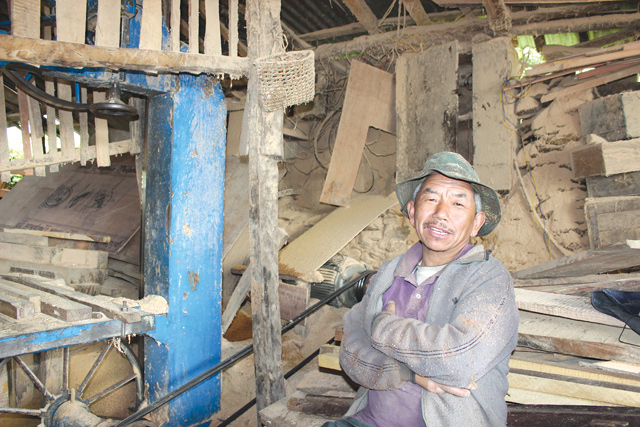
“It was as if all of us were waiting for light,†says Gami Ghale, who runs a rice huller, a flour mill and an oil extractor from her shed, a temporary structure made of green corrugated tin sheets. “The government said it would give us earthquake relief money to rebuild our lives, but we needed power before anything else.â€
Only a few houses in Barpak had held on to their traditional round stone grinders for flour. Many had been forced to walk a couple of hours down to Baluwa Bajar, and then take the bus to Gorkha 50 km away to have their corn and millet ground and their rice hulled.
“It was as if we were back in the middle ages,†Gami Ghale recalls.
Now that Barpak residents have power and can start to rebuild, trucks and tractors will be chugging up to Barpak from Baluwa as soon as the monsoon ends. Local leaders are lobbying to get the Manaslu Development Bank to open a branch in Barpak to distribute relief from the National Reconstruction Authority. At present they have to go to Gorkha.
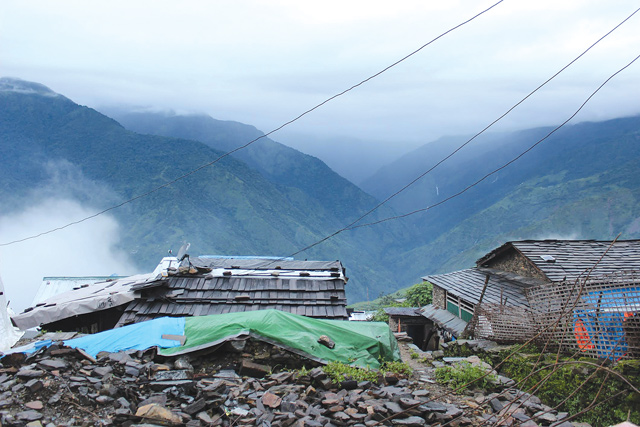
“Four things are required for reconstruction: people, power, roads and bank,†says Jit Bahadur Ghale, owner of the village hardware store and local representative of the Nepali Congress Party, ticking each item off on his fingers.
Gopal Biswokarma — owner of a local metal welding workshop — is waiting for the monsoon to be over. His land was chosen as the site for President Bidya Devi Bhandari to lay the foundation stone to kick off national reconstruction activities. Biswokarma continues to live in his makeshift house, but his business is starting to pick up with the return of power to Barpak.
“Relief rice goes only so far,†he says. “A village cannot live on handouts alone, and reconstruction needs both money as well as people who can do the work.â€
THE GODFATHER
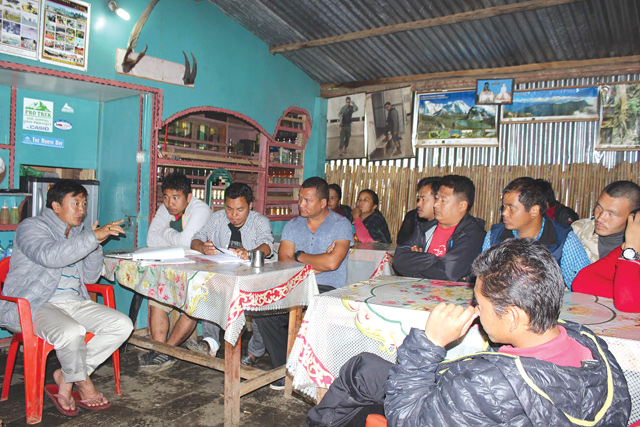
On a rainy morning last week, 26 men and women from Barpak met at the Ruping La guesthouse in Barpak. Chaired by electricity pioneer Bir Bahadur Ghale (pictured, seated at far left), it was the first meeting of the Lhakpa Dorje Agricultural Cooperative, which was being set up to invest in increasing the efficiency of micro-enterprises using power.
Ghatte Khola-3, upgraded from the earlier 50 kW plant, currently produces 130 kW. Ghale sees potential for a cold storage plant for vegetables, a milk-chilling unit, a nettle powder-processing plant, a Lokta paper factory, and other tourism-related services, including a water purification plant.
Ghale and his company Barpak Rural Electrification won the National Geographic Society’s $70,000 Great Energy Challenge 2015 to rehabilitate the Ghatte Khola-3 damaged by the earthquake. Part of the money has gone to set up the Lhakpa Dorje Agricultural Cooperative to incubate and accelerate micro-enterprises.
Sending books not enough
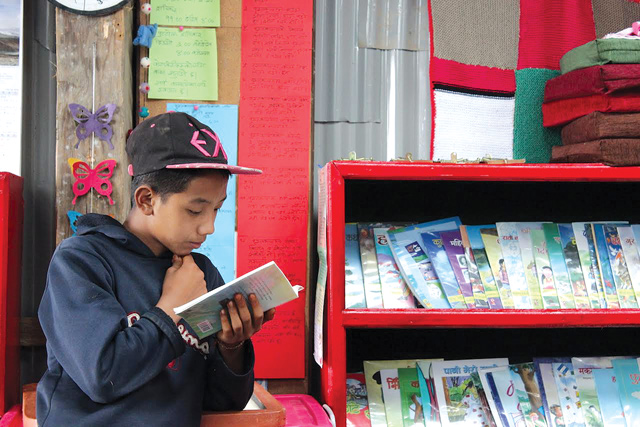
One misty and damp morning high up in Barpak, three 11th graders – Sita, Sanju, and Keyrani – sat in a corrugated tin shed in the Himalaya Higher Secondary School. They were cataloguing, labelling, and putting plastic covers on over 800 children’s books.
The four of us kept getting lost in the books. Most were in full colour, with beautiful illustrations and gripping storylines. “These books are amazing,†said Sanju. “We’ve never seen books like these before.â€
Six months earlier, I had launched a crowdfunding campaign to raise money to build the BarpakChildren’s Learning Centre. I spent two weeks in Kathmandu collecting books and furniture, and learnt to categorise books and ways to get children interested in reading.
We discovered that the school has books in its store. Immediately following the earthquakes, Kathmandu-based publishers had sent a set of all their titles to every school in earthquake-affected districts. However, without clear guidelines many of the books were locked up in sheds with other relief items. Most books were damaged by rain and rodents and had not reached the children they were intended for. A set of books was for schools higher up the mountains, and no one had people to spare to carry them up.
Sita, Sanju, Keyrani and I salvaged what we could, but several were destroyed. It was heartbreaking to see them go to waste, especially since many of the books were from Room to Read, whose books are no longer available in Kathmandu bookstores. I also saw many Rato Bangala Kitab book titles for the first time, as they were out of stock when I had tried to buy them in Kathmandu.
The schools had received the books and other items for children, but had nowhere to put them. With community infrastructure ruined and everyone in the village, including teachers, focused on rescue and recovery, books were not a priority.
Sending books to remote villages — especially to areas that have just suffered a devastating calamity — sounds like a kind, helpful thing to do, but it is not enough. Successful distribution is important, as are simple, clear-cut guidelines for teachers on how to encourage children to read. Teachers need help to create a conducive reading environment and to get children excited about books.
This need not be complicated, and can be as straightforward as sending up a small tent or a waterproof mobile bookrack along with the books, designating a teacher to make the books available to the children, or having older students take turns to read aloud to younger kids. When this happens, kids will actually use and enjoy reading the books that are sent up for them.

